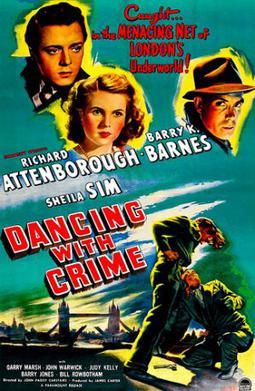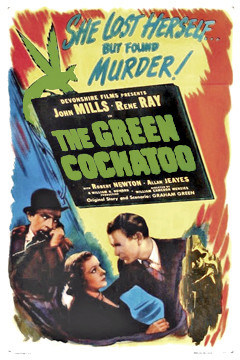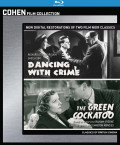| Reviews & Columns |
|
Reviews DVD TV on DVD Blu-ray 4K UHD International DVDs In Theaters Reviews by Studio Video Games Features Collector Series DVDs Easter Egg Database Interviews DVD Talk Radio Feature Articles Columns Anime Talk DVD Savant Horror DVDs The M.O.D. Squad Art House HD Talk Silent DVD
|
DVD Talk Forum |
|
|
| Resources |
|
DVD Price Search Customer Service #'s RCE Info Links |
|
Columns
|
|
|
Dancing with Crime / The Green Cockatoo
An untitled double-feature billed as "Film Noir Classics," Dancing with Crime (1947) and The Green Cockatoo (1937) are really British crime mellers that would be potboilers were it not for the handful of star names in each cast. Further, while both films may have been "digitized in association with the British Film Institute," Cockatoo is obviously derived from secondary elements; it looks okay, but far from great.
Dancing with Crime (1947) is a very ordinary crime thriller with a pedestrian script, though its cast and depiction of early postwar Britain is interesting. A young Richard Attenborough stars as London cabby Ted Peters, engaged to sweetheart Joy Goodall (Sheila Sim, newly Mrs. Attenborough in real-life). Ted's boyhood pal and foxhole buddy Dave Robinson (Bill Owen) works for gangsters operating a black-market syndicate out of the Palais-de-Dance, a swanky dance hall/nightclub. When Dave scoffs at his cut from their most recent heist, the club's M.C., Paul Baker (Barry K. Barnes), actually lieutenant to gang leader Mr. Gregory (Barry Jones), owner of the club, shoots Dave, who dies of his wounds in Ted's taxi, the cabby shaken by his friend's murder. Feeling Det. Insp. Carter (John Warwick) and Sgt. Murray (Garry Marsh) are taking too long to solve the crime, amateur sleuth Ted decides to investigate on his own, enlisting girlfriend Joy to join the club as a dance hostess.
Brock Williams's script, from James Carter's story, spends at least an equal amount of screentime following the actions of the cutthroat gang, who until the end of the film are always at least two steps ahead of both the police and Ted. Since the movie audience is always aware of their actions, suspense is never once generated. The basic story might have worked had the perspective had been entirely from Ted's point of view, clues and revelations presenting themselves gradually instead of watching him figure things out the audience already knew about two reels back.
It also doesn't help that Ted and Joy, swell kids, are almost painfully wholesome and naïve, though Attenborough and Sim are undeniably likeable and their real-life recent marriage adds verisimilitude to their onscreen relationship. But mostly they seem foolish, needlessly putting themselves into dangerous situations.
The most interesting aspect of the film is Barry Jones as the gang's ringleader. The actor alternated between British and Hollywood films (in the latter category, with credits including Seven Days to Noon, Demetrius and the Gladiators, and Brigadoon). He looks and talks more like a detective inspector than a gangster, so that when Gregory pretends to be a police detective visiting Ted at his taxi company's garage, it's easy to see how Ted might easily accept the impersonation. Jones is very good throughout, though as written this "brain heavy" is hardly original.
Beyond the leads, the film is also of interest for Diana Dors, in an uncredited but substantial part as a saucy dance hostess. Incredibly, she was only 15 years old at the time (at this point in her career, Dors was lying about her age) yet already playing British Marilyn Monroe types several years before there was a Monroe type. Also uncredited is Dirk Bogarde, barely recognizable (and seen only in profile) in his first speaking part in a movie.
Though even most exteriors are soundstage sets, Dancing with Crime (a silly title) is interesting for its depiction of early postwar Britain, when luxuries were fiendishly scarce and the black market was thriving in this environment. (*** out of *****)
The Green Cockatoo appears to fall into that category of "quota quickie," made purely to satisfy import-export requirements. It's cheap and runs barely an hour.
John Mills and Robert Newton improbably play brothers, Mills as streetwise song-and-dance man Jim Connor, Newton his brother Dave, who has fallen in with gangsters he unwisely double-crosses by not fixing a race at a dog track. Meanwhile, small town girl Eileen (Rene Ray), seeking her fortune in London, bumps into Dave immediately after his tussle with gangsters who stab him. Dave makes his escape with Eileen's help, she unaware at first of his fatal wound. Checking into a hotel, Dave succumbs, but not before instructing her to go to brother Jim with a cryptic message. People at the hotel and the police wrongly assume she stabbed him.
She makes her way to The Green Cockatoo, a small club where Jim sings and dances for the drunk and disinterested patronage. Why doesn't she realize the man helping her elude the police and various gangsters is Dave's brother? Why does he go out of his way to never ask her what happened? Because then the filmmakers would have had a one-reel movie instead of a six-reel one.
The curious thing about The Green Cockatoo is all the talent it took to make something barely above the level of a Monogram Charlie Chan film. The great production designer William Cameron Menzies directed, Graham Greene wrote the story and scenario, and Miklós Rózsa wrote the musical score. Nothing here is remotely close to their usual high standards. Even Rózsa's music is at a Poverty Row level, and the dialogue is imitation Warner Bros.: When Eileen quotes Shakespeare, Jim asks, "Romeo? Wasn't he a sucker for a good-lookin' dame?"
The one point of interest is John Mills, giving a far better performance than the picture deserves. His character is clearly emulating James Cagney-type tough guys (with her huge eyes, Rene Ray hints at early Bette Davis), but to his credit it turns out Mills really can sing and dance, briefly exhibiting some impressive soft shoe moves. Who knew? (** out of *****)
Video & Audio
A Cohen Media Group release through Kino Lorber, Dancing with Crime looks quite nice, while The Green Cockatoo seems derived from secondary elements, with lots of age-related blemishes and reel change cues and the like. Both are in 1.37:1 black and white with DTS-HD Master audio (2.0 mono), with optional English subtitles. No extras.
Parting Thoughts
I wasn't exactly bored with either film, just disappointed by the utter ordinariness, though their casts are fun to watch. Neither is classic by any measure, noir or otherwise. Rent It.
Stuart Galbraith IV is the Kyoto-based film historian largely absent from reviewing these days while he restores a 200-year-old Japanese farmhouse.
|
| Popular Reviews |
| Sponsored Links |
|
|
| Sponsored Links |
|
|
| Release List | Reviews | Shop | Newsletter | Forum | DVD Giveaways | Blu-Ray | Advertise |
|
Copyright 2024 DVDTalk.com All Rights Reserved. Legal Info, Privacy Policy, Terms of Use,
Manage Preferences,
Your Privacy Choices | |||||||
















